The British sector of the Normandy D-Day beaches, stretching from the historic town of Bayeux, was the site of critical operations during the pivotal Allied invasion. From the daring capture of Pegasus and Horsa Bridges to the fierce battle for Sword Beach, the courage and determination of British forces played a vital role in the eventual liberation of France. Though the price paid was high, the sacrifices of those who fought on these shores will forever be etched in the memories of a grateful nation. What stories lie buried beneath the hallowed ground of Normandy, waiting to be uncovered?
Key Points
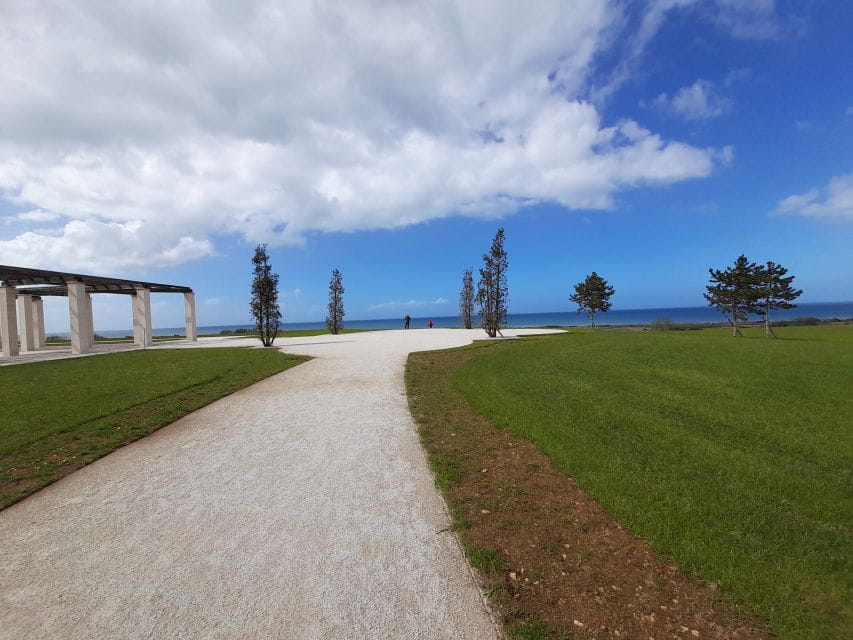
- The Sword Sector, part of the British D-Day landing zone, featured the iconic Pegasus Bridge and Horsa Bridge, captured in a crucial operation.
- The Café Gondree, the first house liberated in France, and the Ranville War Cemetery, with over 2,500 British soldiers’ graves, are poignant reminders of the campaign.
- The 3rd British Division landed on Sword Beach, facing German resistance but securing vital bridges and liberating the town of Ouistreham.
- The 50th Infantry Division secured the beachhead at Gold Beach, capturing Arromanches and disabling the Longues-sur-Mer artillery battery.
- Arromanches and Longues-sur-Mer were crucial to the Allied advance, with the artificial Mulberry B harbor and the threat of the German guns.
Sword Sector Highlights
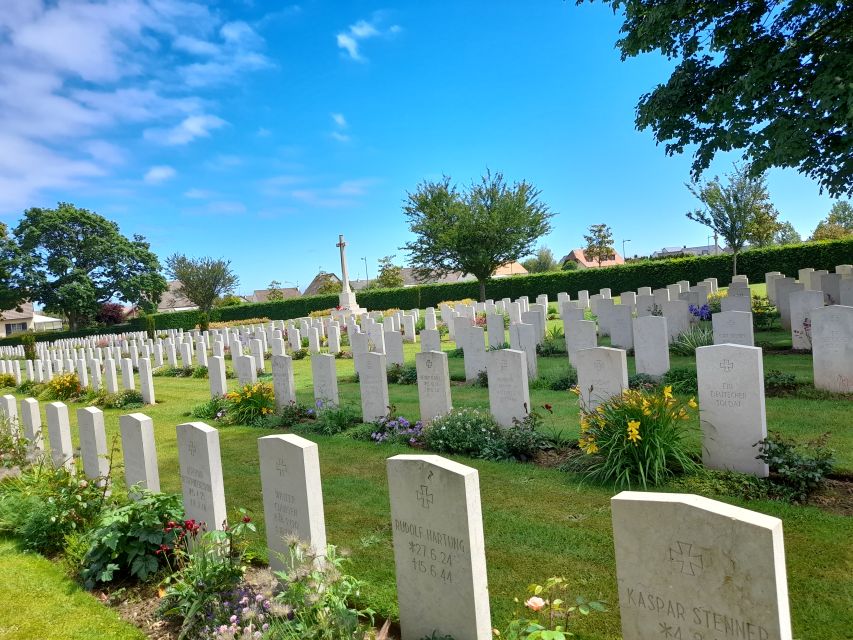
The Sword Sector of the D-Day beaches often captivates visitors with its storied history, as it was the site of the daring Operation Deadstick led by the 6th Airborne Division.
Visitors can explore the renowned Pegasus Bridge and Horsa Bridge, which were captured during this pivotal operation. The memorial for the gliders that landed nearby serves as a poignant reminder of the sacrifices made.
One can also visit the Café Gondréé, the first house liberated in France, and the Ranville War Cemetery, where over 2,500 British soldiers who perished during the invasion are laid to rest.
The Sword Sector’s significance in the D-Day landings continues to inspire awe and reverence among those who come to walk in the footsteps of history.
Want to keep it personal? More private experiences we love in Bayeux
Pegasus Bridge and Horsa Bridge
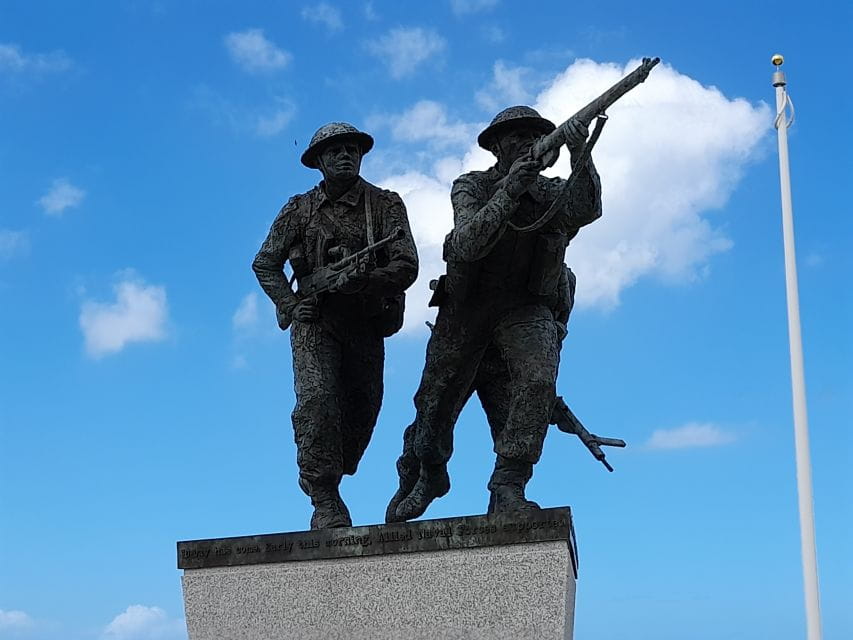
Among the Sword Sector‘s most iconic landmarks are the Pegasus Bridge and Horsa Bridge, which played a pivotal role in the daring Operation Deadstick during the D-Day invasion.
Captured by the British 6th Airborne Division in the early hours of June 6th, 1944, these bridges provided a crucial means of access across the Caen Canal and Orne River, allowing reinforcements and supplies to reach the Allied forces on Sword Beach.
Today, the bridges stand as poignant reminders of the bravery and heroism displayed by the airborne troops, who fought tenaciously to secure these strategic crossings.
Visitors can explore the surrounding area, which includes a memorial commemorating the gliders that landed nearby, and the Café Gondree, the first house liberated in France on D-Day.
Café Gondrée and Ranville Cemetery
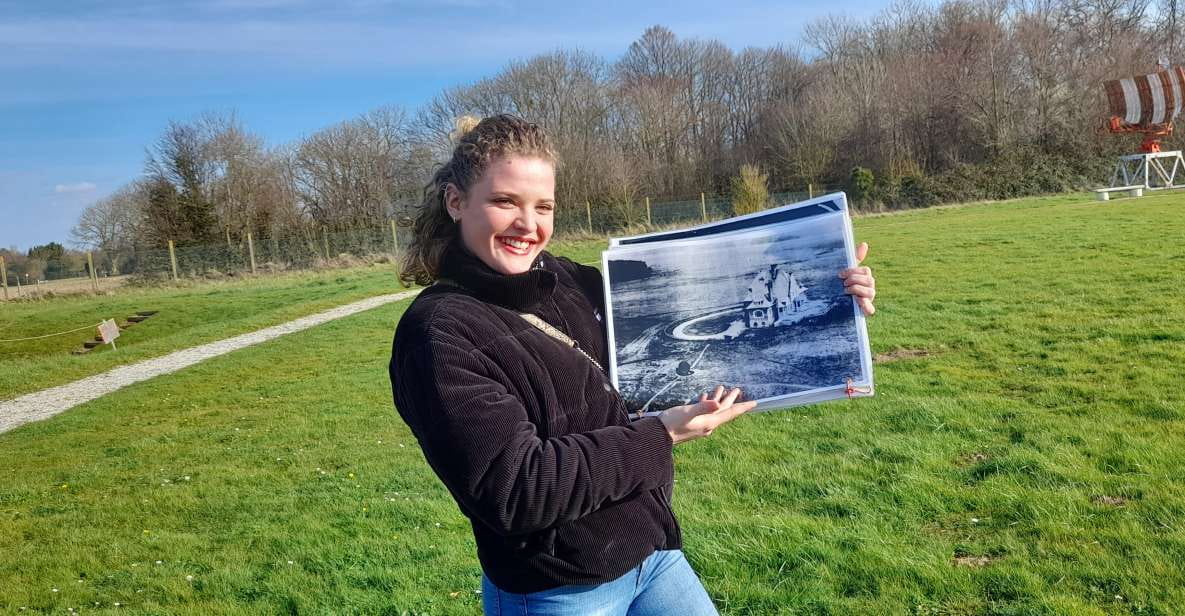
Mere steps from the iconic Pegasus Bridge, one finds the Café Gondree, the first house in France liberated on the fateful day of D-Day.
This modest hotel, owned by the Gondree family, stands as a poignant reminder of the Allied troops’ heroic feats, welcoming visitors with its warm hospitality and historical significance.
Just beyond the café’s threshold lies the Ranville War Cemetery, a solemn resting place for over 2,500 British soldiers who paid the ultimate price in the quest to secure a foothold on Normandy’s shores.
Rows of pristine white headstones mark the graves of these brave men, a haunting yet dignified testament to the sacrifices made during the pivotal Normandy campaign.
Sword Beach Landing
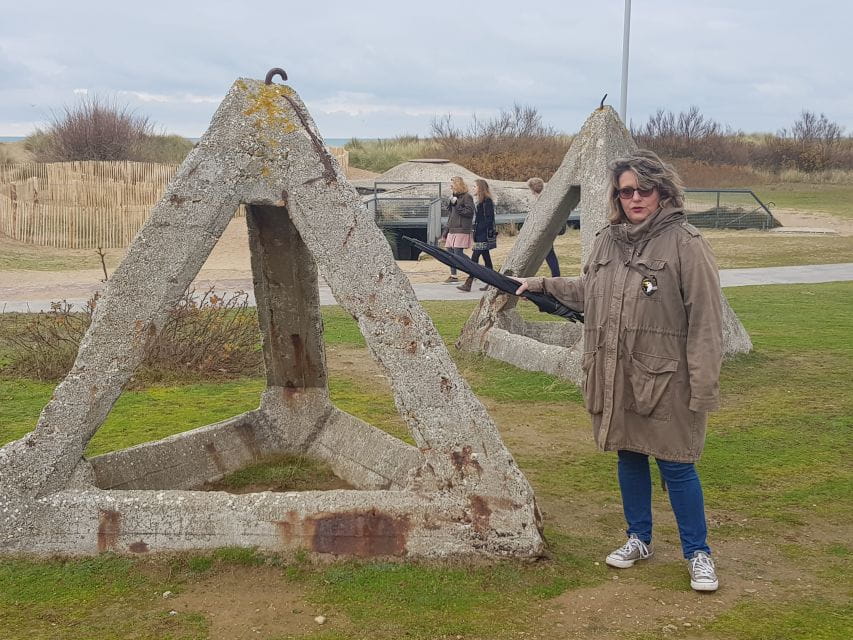
On June 6th, 1944, the 3rd British Division landed on Sword Beach, their assault led by the seasoned troops of the 8th and 9th Brigades. Approaching the shore under a hail of enemy fire, they fought tenaciously to secure a foothold, marking the beginning of the Allied push inland from the Normandy coastline.
Though facing stiff German resistance, the British forces advanced rapidly, capturing key objectives:
- Securing Pegasus and Horsa Bridges, vital to the 6th Airborne Division’s mission
- Liberating the town of Ouistreham, the first in France to be freed from Nazi occupation
- Linking up with Canadian forces to the west and American forces to the east
Establishing a beachhead that would support the continued Allied advance into Normandy.
More Great Tours Nearby50th Infantry Division at Gold Beach
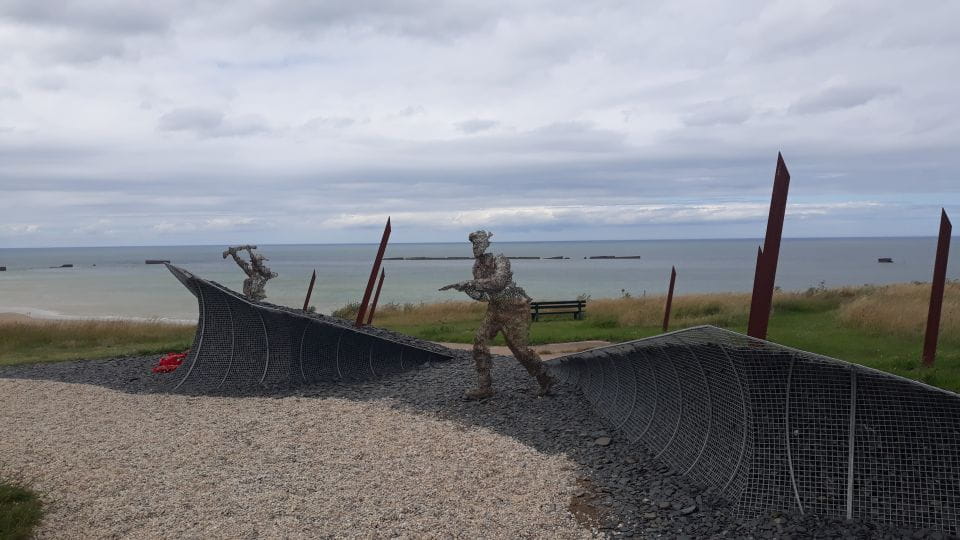
The 50th Infantry Division landed on Gold Beach, determined to secure their objectives and push inland. Facing stiff German resistance, the seasoned British troops fought their way off the beach, capturing the key town of Arromanches and establishing the vital Mulberry B artificial harbor. Despite the fierce fighting, they pressed on, steadily advancing towards their goals and contributing to the overall Allied offensive in Normandy.
| Gold Beach Objectives | Arromanches Artificial Port | Longues-sur-Mer Artillery Battery |
|---|---|---|
| Secure beachhead | Capture town | Disable 150mm guns |
| Push inland | Establish Mulberry B | Neutralize threat |
| Support overall offensive | Aid Allied supply lines | Protect advancing troops |
- Omaha and Utah Beaches
- Mont Saint-Michel Day Trip From Bayeux (Shared Tour)
- American D-Day Beaches Private Tour Full Day Tour From Bayeux
- Omaha Beach Half-Day Morning Trip From Bayeux (A1)
- Omaha Afternoon Half Day Tour to Visit the Landing Areas at Omaha Beach
- Normandy American & British DDAY Beaches Halfday Tour From Bayeux
Arromanches and Longues-sur-Mer Artillery Battery
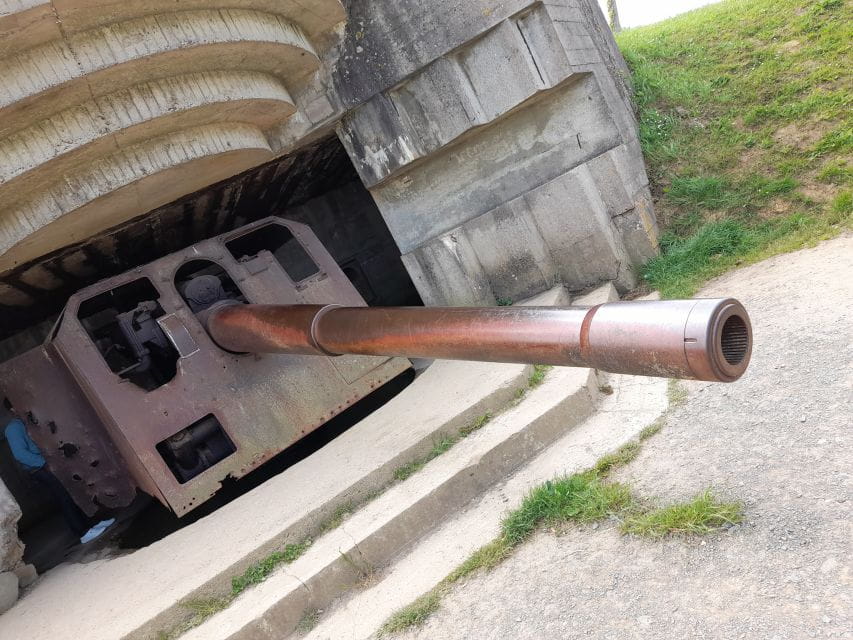
Arromanches’ Mulberry B artificial harbor stood as a testament to the Allies’ engineering prowess.
The bustling port of Arromanches allowed the Allies to offload thousands of tons of vital supplies and equipment, a crucial factor in their ultimate victory.
The imposing Longues-sur-Mer artillery battery posed an unrelenting threat to their advancing forces.
The four German 150mm guns at Longues-sur-Mer inflicted heavy casualties on the invading forces until they were finally silenced by British naval bombardment.
The site’s preserved bunkers and gun emplacements serve as a somber reminder of the fierce struggle that took place on these hallowed shores.
Tour Inclusions and Customization
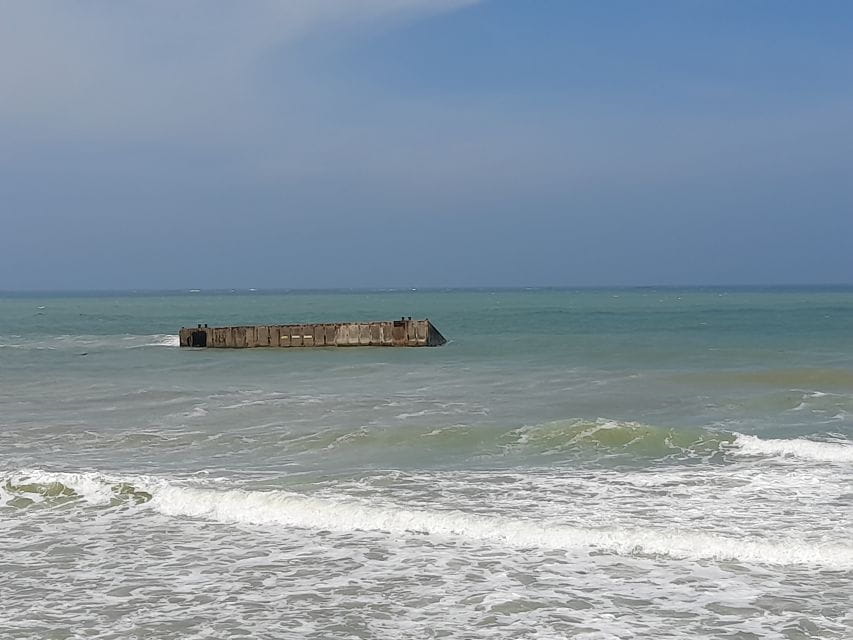
The tour’s inclusions ensure a comprehensive and convenient experience for visitors, with hotel pickup and drop-off, a PA audio system, and all entry fees covered.
Guests can also avail of free wheelchair accessibility and customized tours tailored for disabled individuals, underscoring the tour organizers’ commitment to inclusivity.
Water and the guide’s lunch are further inclusions that enhance the overall comfort and enjoyment of the day.
This thoughtful attention to detail allows visitors to fully enjoy the history and significance of the D-Day battlefields, without having to worry about logistics or accessibility challenges.
The tour’s flexibility and inclusive approach make it an appealing choice for a wide range of travelers seeking an enriching and memorable Normandy experience.
Pickup and Drop-off
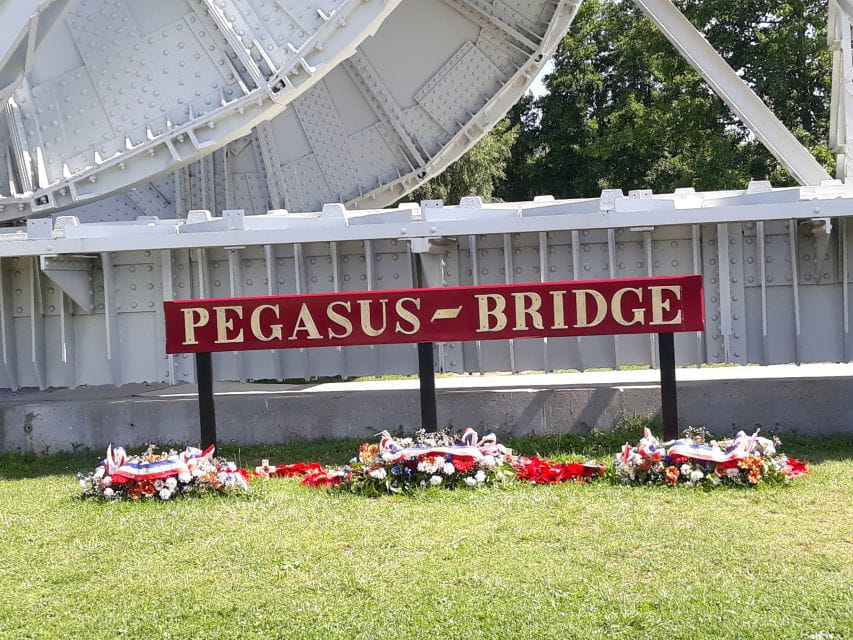
One of the key conveniences of this Normandy D-Day tour is the included pickup and drop-off service, which whisks visitors from their Bayeux accommodations to the historic sites along the Sword Sector. This hassle-free transportation allows guests to fully enjoy the poignant stories and landmarks of this pivotal World War II battle, without the burden of navigating the region on their own.
The personalized pickup service ensures a seamless start to the day, with a knowledgeable guide ready to greet and guide you.
The return drop-off at the end of the tour allows for a comfortable, reflective journey back to your lodgings in Bayeux.
This inclusive transportation service caters to all visitors, including those with mobility challenges, making the tour accessible and convenient.
The worry-free pickup and drop-off allow guests to focus on the profound experience of walking in the footsteps of the brave Allied forces.
Frequently Asked Questions

Is the Tour Guide Fluent in Multiple Languages?
The guide is likely fluent in multiple languages to accommodate the diverse group of visitors. They can provide engaging historical insights and personalized attention, ensuring a memorable experience for all.
Can the Tour Be Customized for Different Group Sizes?
The tour can be customized for different group sizes. The operator offers personalized experiences, allowing visitors to explore the historic sites at their own pace and adapt the itinerary to their interests and needs.
Are There Any Restrictions on the Type of Vehicles Used?
The tour offers flexible transportation, with pickups from Bayeux and wheelchair-accessible vehicles available. Guests can customize the experience to accommodate their group size and mobility needs, ensuring a comfortable and memorable journey through the historic D-Day sites.
Can Visitors Take Photos and Videos During the Tour?
Visitors are encouraged to take photos and record videos throughout the tour. Capturing the historic sites and solemn memorials allows guests to preserve their cherished memories of this poignant journey through the hallowed grounds of the D-Day Beaches.
Are There Any COVID-19 Safety Protocols in Place?
The tour operator has implemented COVID-19 safety protocols to protect guests. Visitors will find hand sanitizer available, masks required, and social distancing encouraged throughout the tour. These measures ensure a safe and enjoyable experience exploring the historic Normandy battlefields.
Recap
The British forces’ pivotal capture of Pegasus and Horsa Bridges, along with their courageous landing at Sword Beach, played a crucial role in the Allied invasion of Normandy.
The liberation of Ouistreham marked a significant milestone, as the British sector witnessed the first town in France to be freed from Nazi occupation.
This historic campaign left an indelible mark, forever etching the bravery and sacrifices of the British troops in the annals of D-Day.
You can check availability for your dates here:More Private Tours in Bayeux
More Tour Reviews in Bayeux
Not for you? Here's more things to do in Bayeux we have recnetly reviewed
- Normandy Landing Beaches: Private Day Tour from Bayeux
- D-day: Omaha Beach tour with transportation from Bayeux
- From Paris: Normandy D-Day Beaches Full-Day Historical Tour
- Omaha Beach : Guided Electric Bike Tour
- From Bayeux: American D-Day Sites in Normandy Full-Day Tour
- From Bayeux: Mont-Saint Michel Guided Tour
- Normandy: 2 Days Tour D-Day, Normandy from Bayeux
- Discover Bayeux: A Private Walking Tour With Local Guide
- D-Day Unveiled : Museums & Mulberry Harbors Tour from Bayeux
- E-Bike food tour !
- Bayeux: Normandy D-Day Landing Beaches Full-Day Guided Tour
- Bayeux: 9.30 DAILY 2-HOUR WALKING GROUP CITY TOUR IN ENGLISH
